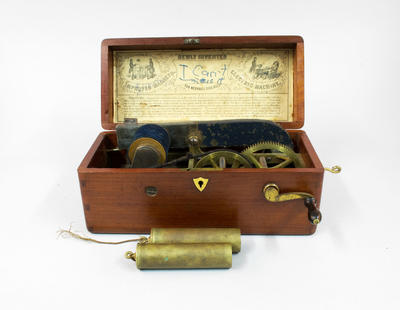Machine - Magneto-Electric
Object detail
Accession number
1970.313.1
Description
Magneto-Electric machine. Wooden box with hinged lid. Lock at front. Handle at front. Interior contains large magnet and mechanisms that rotate when the handle is turned. Also contains two metal cylinders that the patient holds. Paper label on underside of lid with instructions for use.
Brief History
In the 1800s, mild electric shocks were a popular treatment for a range of aches and pains, especially those associated with the nerves. Although little more than medical quackery, thousands of machines such as this one were made. Electricity was produced using the large magnet and the strength of the electric shock was controlled by how fast the crank was turned. The operator would place the handles in the patient’s hands or on their body to deliver the shock. To prevent the patient feeling too much pain, it was recommended that a wet sponge be placed between the handle and the body.
The application of electric currents was thought to stimulate muscles and nerves to reduce harmful symptoms, and magneto-electric machines were said to cure diseases such as tuberculosis, cancer and heart disease. These machines were also the precursors to polarising psychiatric treatments such as electroconvulsive therapy (ECT).
The application of electric currents was thought to stimulate muscles and nerves to reduce harmful symptoms, and magneto-electric machines were said to cure diseases such as tuberculosis, cancer and heart disease. These machines were also the precursors to polarising psychiatric treatments such as electroconvulsive therapy (ECT).
Marks
Newly Invented / Improved Magneto-Electric Machine / For Nervous Diseases Label
I can't fies / it / I can't / aises it Hand-written
I can't fies / it / I can't / aises it Hand-written
Other name
Electric shock machine
Credit Line
Machine - Magneto-Electric, 1970.313.1. The Museum of Transport and Technology (MOTAT).


Public comments
Be the first to comment on this object record.